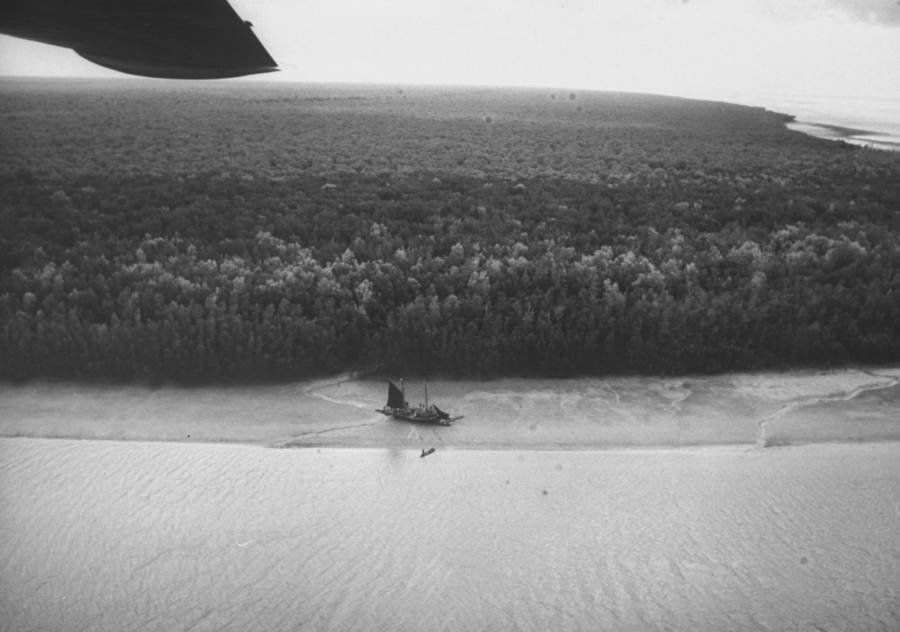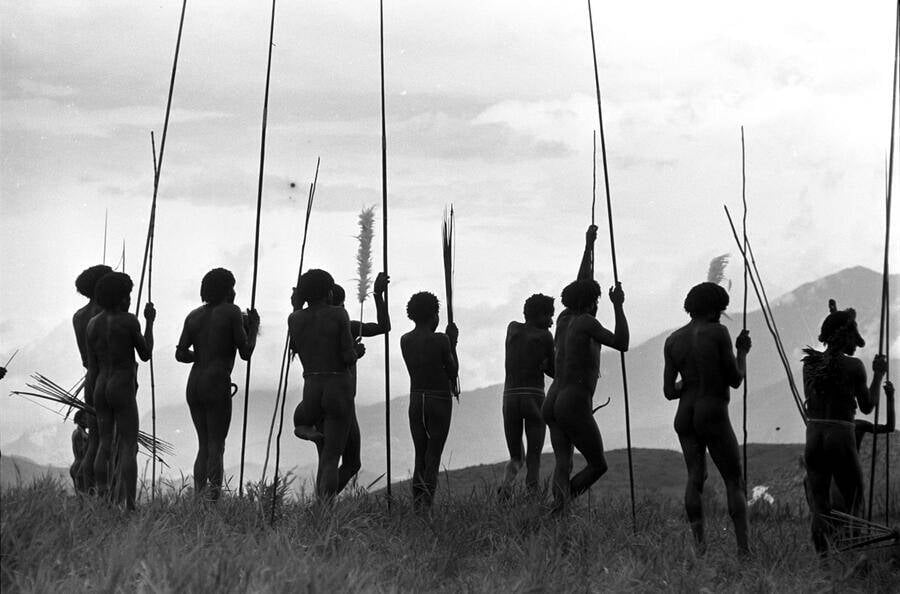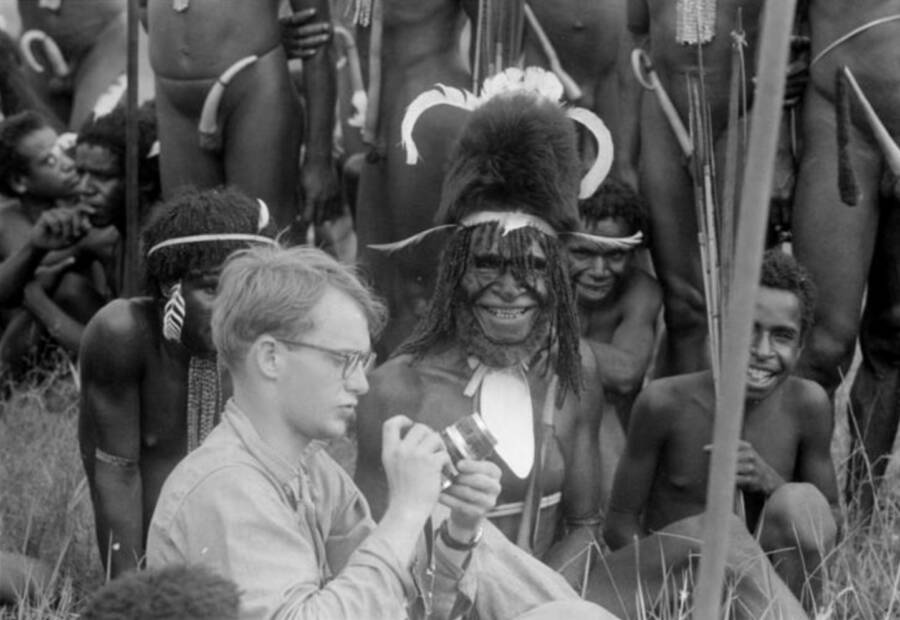Budding ethnographer Michael Rockefeller vanished during his 1961 trip to New Guinea — then evidence emerged that he was killed and eaten by local tribespeople.
The great-grandson of John D. Rockefeller, aspiring explorer and ethnographer Michael Rockefeller had no interest in managing his family’s empire upon graduating from Harvard in 1960. Instead, he set out for the remote wilds of Dutch New Guinea to collect art made by the largely uncontacted Asmat people.
But before he could complete his second journey to meet the Asmat in November 1961, Rockefeller’s boat capsized off New Guinea’s southern coast and he was forced to attempt an arduous swim to shore. That was the last anyone ever heard from him.
Despite a gargantuan search effort and a media firestorm, Michael Rockefeller was never found and the authorities eventually declared him dead due to drowning in 1964.

President and Fellows of Harvard University; Peabody Museum of Archeology and Ethnology Michael Rockefeller on his first trip to New Guinea in May 1960, just one year before his death.
But in the decades since, various independent investigators and writers claim to have uncovered evidence that the authorities actually buried the truth about Michael Rockefeller’s death because it was simply too horrific to reveal. Allegedly, Rockefeller made it to shore, but was murdered and eaten by the Asmat.
This is the haunting story of Michael Rockefeller.
Michael Rockefeller Embarks Upon A Life Of Adventure
Michael Clark Rockefeller was born in 1938. He was the youngest son of New York governor Nelson Rockefeller and the newest member of a dynasty of millionaires founded by his famous great-grandfather, John D. Rockefeller — one of the richest people who ever lived.

Keystone/Hulton Archive/Getty ImagesNew York Governor Nelson A. Rockefeller (seated) with his first wife, Mary Todhunter Clark, and children, Mary, Anne, Steven, Rodman and Michael.
Though his father expected him to follow in his footsteps and help manage the family’s vast business empire, Michael Rockefeller was a quieter, more artistic spirit. When he graduated from Harvard in 1960, he wanted to do something more exciting than sit around in boardrooms and conduct meetings.
His father, a prolific art collector, had recently opened the Museum of Primitive Art, and its exhibits, including Nigerian, Aztec, and Mayan works, entranced Michael.
He decided to seek out his own “primitive art” (a term no longer in use that referred to non-Western art, particularly that of Indigenous peoples) and took a position on the board of his father’s museum.
It was here that Michael Rockefeller felt he could make his mark. Karl Heider, a graduate student of anthropology at Harvard who worked with Michael, recalled, “Michael said he wanted to do something that hadn’t been done before and to bring a major collection to New York.”
He had traveled extensively already, living in Japan and Venezuela for months at a time, and he craved something new: he wanted to embark on an anthropological expedition to a place few would ever see.

Nielsen/Keystone/Hulton Archive/Getty ImagesMichael Rockefeller was determined to set out on his own and travel to the farthest reaches of the Earth.
After talking with representatives from the Dutch National Museum of Ethnology, Michael decided to make a scouting trip to what was then known as Dutch New Guinea, a massive island off the coast of Australia, to collect the art of the Asmat people who resided there.
Rockefeller’s First Expedition To New Guinea
By the 1960s, Dutch colonial authorities and missionaries had already been on the island for almost a decade, but many Asmat people had never seen a white man.
With severely limited contact with the outside world, the Asmat believed the land beyond their island to be inhabited by spirits, and when white people came from across the sea, they saw them as some kind of supernatural beings.
Michael Rockefeller and his team of researchers and documentarians were thus a curiosity to the village of Otsjanep, home to one of the major Asmat communities on the island, and not an entirely welcome one.

Eliot Elisofon/Harvard University Peabody Museum of Archaeology & EthnologyThe Harvard-Peabody expedition to New Guinea in 1961, with Michael Rockefeller seated second from right.
The locals put up with the team’s photography, but they didn’t allow the white researchers to purchase cultural artifacts, like bisj poles, intricately carved wooden pillars that serve as part of Asmat rituals and religious rites.
Michael was undeterred. In the Asmat people, he found what he felt was a fascinating violation of the norms of Western society — and he was more anxious than ever to bring their world back to his.
At the time, war between villages was common, and Michael Rockefeller learned that Asmat warriors often took the heads of their enemies and ate their flesh. In certain regions, Asmat men would engage in ritual homosexual sex, and in bonding rites, they would sometimes drink each other’s urine.
“Now this is wild and somehow more remote country than what I have ever seen before,” Michael wrote in his diary.
When the initial scouting mission concluded, Michael Rockefeller was energized. He wrote out his plans to create a detailed anthropological study of the Asmat and display a collection of their art in his father’s museum.
Michael Rockefeller Returns To Study The Asmat — And Disappears

Jan Broekhuijse/Harvard University Peabody Museum of Archaeology & EthnologyMichael Rockefeller during his 1961 expedition to New Guinea.
Michael Rockefeller set out once again for New Guinea in 1961, this time accompanied by René Wassing, a government anthropologist.
As their boat approached Otsjanep on November 19, 1961, a sudden squall churned the water and riled crosscurrents. The boat capsized, leaving Michael and Wassing clinging to the overturned hull.
Though they were 12 miles from the shore, Michael reportedly told the anthropologist, “I think I can make it” — and he jumped into the water.
He was never seen again.

Rich and politically connected, Michael’s family ensured that no expense was spared in the search for the young Rockefeller. Ships, airplanes, and helicopters scoured the region, searching for Michael or some sign of his fate.
Nelson Rockefeller and his wife flew to New Guinea to help in the search for their son.
Despite their efforts, they were unable to find Michael’s body. After nine days, the Dutch interior minister stated, “There is no longer any hope of finding Michael Rockefeller alive.”
Though the Rockefellers still thought there was a chance Michael might yet appear, they left the island. Two weeks later, the Dutch called off the search. Michael Rockefeller’s official cause of death was put down as drowning.

Eliot Elisofon/The LIFE Picture Collection/Getty ImagesThe south coast of New Guinea, where Michael Rockefeller went missing.
The mysterious disappearance of Michael Rockefeller was a media sensation. Rumors spread like wildfire in tabloids and newspapers.
Some said he must have been eaten by sharks on his swim to the island. Others claimed he was living somewhere in the jungle of New Guinea, escaping from the gilded cage of his wealth.
The Dutch denied all these rumors, saying that they were unable to discover what had happened to him. He had simply vanished without a trace.
The Rockefeller Cold Case Is Reopened
In 2014, Carl Hoffman, a reporter for National Geographic, revealed in his book Savage Harvest: A Tale of Cannibals, Colonialism and Michael Rockefeller’s Tragic Quest for Primitive Art that many of the Netherlands’ inquiries into the matter resulted in evidence that the Asmat killed Michael.
Two Dutch missionaries on the island, both of whom had lived among the Asmat for years and spoke their language, told local authorities that they had heard from the Asmat that some of them had killed Michael Rockefeller.

Michael Rockefeller/Harvard University Peabody Museum of Archaeology & EthnologyMichael Rockefeller captured this photo of tribespeople in New Guinea holding spears in preparation for battle.
The police officer sent to investigate the crime the following year, Wim van de Waal, came to the same conclusion and even produced a skull that the Asmat claimed belonged to Michael Rockefeller.
All of these reports were summarily buried in classified files and not further investigated. The Rockefellers were told that there was nothing to the rumors that their son had been killed by natives.
Why suppress the stories? By 1962, the Dutch had already lost half of the island to the new state of Indonesia. They feared that if it were believed they could not control the native population, they would be quickly ousted.
How Michael Rockefeller Died At The Hands Of Cannibals

Wikimedia CommonsHow the Asmat people decorate the skulls of their enemies.
When Carl Hoffman decided to investigate these 50-year-old claims about Michael Rockefeller’s death, he started by traveling to Otsjanep. There, posing as a journalist documenting the culture of the Asmat people, his interpreter overheard a man telling another member of the tribe not to discuss the American tourist who had died there.
When the interpreter, at Hoffman’s urging, asked who the man was, he was told it was Michael Rockefeller. He learned that it was common knowledge on the island that the Asmat people of Otsjanep killed a white man and that it should not be mentioned for fear of reprisals.
He also learned that the killing of Michael Rockefeller was a reprisal in its own right.
In 1957, just three years before Rockefeller first visited the island, a massacre occurred between two Asmat tribes: the Otsjanep and Omadesep villages killed dozens of each other’s men.
The Dutch colonial government, having only recently taken control of the island, attempted to put a stop to the violence. They went to disarm the remote Otsjanep tribe, but a series of cultural misunderstandings resulted in the Dutch opening fire on the Otsjanep.
In their first encounter with firearms, the village of Otsjanep witnessed four of their jeus, war leaders, shot and killed.
It was in this context that Otsjanep tribesmen stumbled upon Michael Rockefeller as he backstroked toward the shore bordering their lands.

Wolfgang Kaehler/LightRocket/Getty ImagesAsmat tribesmen on a canoe.
According to the Dutch missionary who first heard the story, the tribesmen initially thought Michael was a crocodile — but as he drew closer, they recognized him as a tuan, a white man like the Dutch colonizers.
Unfortunately for Michael, the men he encountered were jeus themselves and the sons of those killed by the Dutch.
One of them reportedly said, “People of Otsjanep, you’re always talking about headhunting tuans. Well, here’s your chance.”
Though they were hesitant, mostly out of fear, they eventually speared and killed Michael Rockefeller.

Jan Broekhuijse/Harvard University Peabody Museum of Archaeology & EthnologyMichael Rockefeller among the Asmat in New Guinea in 1961.
Then they cut off his head and cleaved his skull to eat his brain. They cooked and ate the rest of his flesh. His thigh bones were turned into daggers, and his tibias were made into points for fishing spears.
His blood was drained, and the tribesmen drenched themselves in it while they performed ritual dances and sex acts.
In accordance with their theology, the people of Otsjanep believed they were restoring balance to the world. The “tribe of the white man” had killed four of them, and now they had taken retribution. By consuming the body of Michael Rockefeller, they could absorb the energy and power that had been taken from them.
Burying The Secret Of Michael Rockefeller’s Death

Wikimedia CommonsAsmat tribesmen gathered in a longhouse.
It wasn’t long before the village of Otsjanep came to regret the decision. The search that followed the murder of Michael Rockefeller was terrifying to the Asmat people, most of whom had never seen a plane or helicopter before.
Directly following this event, the region was also plagued by a horrible cholera epidemic that many saw as revenge for the murder.
Though many Asmat people told this story to Hoffman, no one who took part in the death would come forward; all simply said it was a story they had heard.
Then, one day when Hoffman was in the village, shortly before he returned to the U.S., he saw a man miming a killing as part of a story he was telling to another man. The tribesman pretended to spear someone, shoot an arrow, and chop off a head. Hearing words relating to the murder of Michael Rockefeller, Hoffman began to film — but the story was already over.
Hoffman was, however, able to catch its epilogue on film:
“Don’t you tell this story to any other man or any other village, because this story is only for us. Don’t speak. Don’t speak and tell the story. I hope you remember it and you must keep this for us. I hope, I hope, this is for you and you only. Don’t talk to anyone, forever, to other people or another village. If people question you, don’t answer. Don’t talk to them, because this story is only for you. If you tell it to them, you’ll die. I am afraid you will die. You’ll be dead, your people will be dead, if you tell this story. You keep this story in your house, to yourself, I hope, forever. Forever…”
With those chilling words, we’re left with just a glimpse of the horrible fate that befell Michael Rockefeller in 1961.
After reading about Michael Rockefeller’s death, meet James Jameson, heir to the famous whiskey empire, who once bought an Indigenous girl just to watch her be eaten by cannibals. Then, read about the most disturbing cannibal attacks in history.





